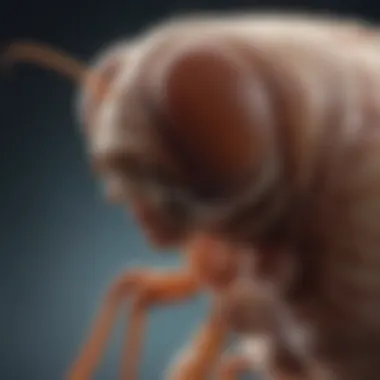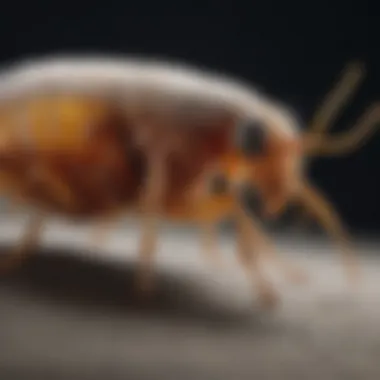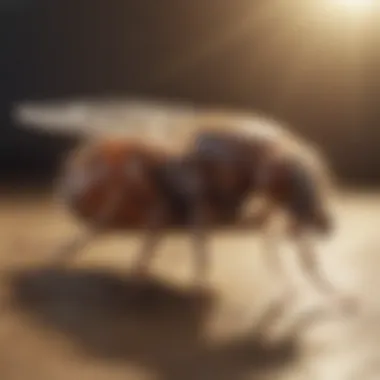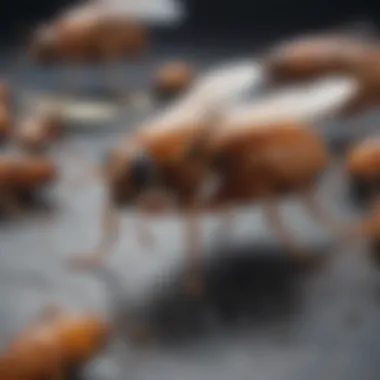Understanding Flea Diseases: Health Risks and Solutions


Intro
Fleas are not merely a nuisance; they pose significant health risks to both humans and animals. Understanding flea diseases requires a thorough examination of flea biology, the diseases they carry, and the management strategies that can mitigate their impact. This overview offers insight into these components, providing essential information for homeowners, pest control professionals, and anyone curious about flea management.
Pest Identification
Detailed descriptions of common pests
Fleas belong to the order Siphonaptera, which includes several species that often invade homes. The most prevalent species is the cat flea, Ctenocephalides felis, which can also be found on dogs and other mammals. Adult fleas are small, usually about 1/8 inch in size, and are characterized by their flat bodies that allow them to move easily through fur. Color-wise they often appear reddish-brown.
Another common species is the dog flea, Ctenocephalides canis. Although similar in appearance to the cat flea, it primarily infests dogs. Less frequently encountered in domestic settings is the human flea, Pulex irritans, which can pose threats in areas where people and animals gather.
Signs and symptoms of infestations
Identifying flea infestations can be straightforward if you are aware of some key indicators:
- Flea bites: Small, itchy red spots often appear on the skin after fleas bite.
- Flea dirt: This is flea feces that resembles black pepper. If you find this on bedding or carpets, it indicates an infestation.
- Unusual scratching: Pets often scratch excessively due to irritation caused by flea bites.
- Visible fleas: Adult fleas can sometimes be seen hopping on pets or surfaces.
It is crucial to recognize these signs early to prevent a larger infestation.
Prevention Strategies
Home maintenance tips for pest prevention
Preventing flea infestations starts with home maintenance. Here are some strategies:
- Regular vacuuming: Use a vacuum to clean carpets, rugs, and upholstery. This helps remove fleas and their eggs from your home.
- Wash bedding: Regularly wash pet bedding and human bedding in hot water to kill any active fleas and their larvae.
- Seal entry points: Close gaps and crevices to prevent fleas from entering your home from outdoor areas.
Natural deterrents and barriers
Using natural methods can be an effective way to deter fleas. Consider:
- Diatomaceous earth: Sprinkling food-grade diatomaceous earth in pet areas can help eliminate fleas as it dries them out upon contact.
- Essential oils: Oils such as lavender and cedar can repel fleas. Mix them with a carrier oil and apply them to pet fur sparingly.
- Maintaining a clean yard: Keep grass trimmed and remove leaves to reduce flea habitats.
Treatment Options
Overview of chemical vs. natural treatments
When addressing a flea infestation, two primary categories of treatments exist: chemical and natural. Chemical treatments often involve topical solutions or oral medications specifically designed for pets. Brands such as Frontline and Advantage provide effective solutions and should be used according to package instructions. Natural treatments include using products like apple cider vinegar or baking soda as alternative methods to control fleas.
Step-by-step guides for DIY treatments
For a DIY approach, follow these steps:
- Create a flea trap: Place a shallow dish of soapy water under a light source overnight. Fleas are attracted to the light and will get trapped.
- Use vacuum cleaner: This should be done daily in areas where pets spend time. Empty the vacuum canister outside to prevent fleas from re-entering.
- Wash fabrics: Clean all pet bedding and fabric items in your home weekly to keep fleas at bay.
By understanding fleas and their diseases, individuals can protect themselves and their pets effectively. This includes recognizing infestations early, employing preventive methods, and choosing appropriate treatment options.
Intro to Fleas
Fleas are small, wingless insects that impact both humans and animals, making their biology and behaviors significant in understanding flea-borne diseases. Knowledge about fleas is essential, especially for homeowners and pest control professionals, as it highlights their lifecycle, their roles in various ecosystems, and the diseases they may transmit.
Fleas serve not only as nuisances but also as vectors for pathogens, leading to various health risks. Understanding their biological characteristics can aid in pest control efforts, preventing infestations and mitigating health risks for both pets and people. The significance of studying fleas extends to their role in ecosystems, where they influence other species, and this interaction contributes to biodiversity.
Overall, comprehending fleas will lead to better management strategies. The following sections will explore various aspects of fleas, detailing their biology, lifecycle, and ecological impacts.


Flea-Borne Diseases
Flea-borne diseases are critical to understand when discussing the implications of fleas as pests. Fleas are not just a nuisance; they can act as vectors for various ailments that affect both human and animal health. Understanding these diseases contributes to a well-rounded approach to pest management and public awareness. Discussions around flea-borne diseases underscore the need for prevention and treatment methods. This awareness can lead to proactive measures that minimize health risks associated with flea infestations.
Overview of Common Flea Diseases
Fleas are primarily known for transmitting several diseases. Among these diseases, one can find flea-borne typhus, cat scratch fever, and tapeworm infections. Each of these conditions arises due to the feeding behavior of fleas. As they bite their hosts, fleas can introduce various pathogens into the bloodstream. Furthermore, the consequences of these diseases can vary significantly, affecting humans and animals differently.
Transmission Mechanisms
Flea-borne diseases depend heavily on the transmission mechanisms of fleas. Fleas are capable of transmitting pathogens via their saliva when they bite. They can also infect hosts indirectly through feces, which can contaminate the environment. When the infected flea bites again, the pathogens can enter the new host. This method of transmission highlights why effective flea control is necessary in homes and communities to break the cycle of disease spread.
Impact on Human Health
Flea infestations can contribute significantly to various health issues in humans.
Allergic Reactions
Allergic reactions are a common issue linked with flea bites. These reactions may cause itching, redness, and swelling at the site of the bite. In some cases, they can lead to severe discomfort and secondary infections from excessive scratching. These reactions are particularly relevant in households with sensitive individuals. Therefore, recognizing and addressing flea infestations is beneficial to avoid these allergenic effects.
Skin Infections
Skin infections resulting from flea bites can occur when the skin barrier is compromised. The intense itching can cause individuals to scratch, leading to breaks in the skin. Bacteria can then enter these openings, resulting in infections. Skin infections are especially concerning for people with underlying health conditions, making effective flea management imperative.
Vector for Other Pathogens
Fleas can act as vectors for additional pathogens. For example, fleas can transmit Rickettsia typhi, which causes flea-borne typhus. This disease can cause fever, headaches, and other systemic symptoms in infected individuals. The role of fleas as vectors emphasizes the importance of managing flea populations thoroughly to reduce the chances of these infections spreading.
Impact on Animal Health
Fleas can have severe consequences for animal health as well.
Flea Allergy Dermatitis
Flea allergy dermatitis is a common condition affecting pets. Animals with this allergy experience extreme itching and skin lesions as a reaction to flea saliva. This condition can severely impact an animal's quality of life and requires veterinary intervention. Understanding this ailment allows pet owners to be more vigilant about flea prevention and treatment.
Tape Worm Transmission
Fleas are also known to transmit tapeworms to animals. When pets ingest infected fleas during grooming, they can become infected with tapeworms. This condition can lead to digestive issues and nutritional complications in pets. This risk emphasizes the need for regular flea control to protect the health of household animals.
Anemia in Infested Animals
Severe flea infestations can lead to anemia in pets. Fleas feed on blood, and a large number of bites can deplete an animal’s blood supply. This issue is particularly severe in young animals or those already compromised by other health issues. Recognizing the signs of flea infestation early can help prevent anemia and other related problems in pets.
Flea-borne diseases pose significant threats to both humans and animals, making effective management and prevention vital for health.
Identifying Flea Infestations
Identifying flea infestations is a critical step in managing them effectively. Early detection minimizes the risk of health issues associated with fleas, both for humans and pets. Recognizing the signs of infestation allows for timely intervention and treatment, thus reducing the overall impact on household hygiene and comfort.
Signs of Flea Infestations
Identifying the presence of fleas early can prevent serious issues. Signs are clear indicators of infestation, and understanding these can help homeowners take prompt action.
Presence of Flea Dirt


Flea dirt, often seen as small dark specks, is a significant sign of flea presence. This dirt is, in fact, flea feces made up of digested blood. Even a small amount can indicate that fleas are feeding on either pets or humans. Besides being a telltale sign, recognizing flea dirt is beneficial in diagnosing the problem, as it directs attention to areas where fleas are likely to be breeding. Its unique feature is its ability to serve as a diagnostic tool, distinguishing it from regular debris. However, some may overlook flea dirt, leading to prolonged infestations.
Scratching and Irritation
Excessive scratching by pets is another important sign. Fleas cause itchy, irritated skin due to bites. Pets might frequently scratch, bite, or lick areas of their skin. This behavior can lead to skin lesions and infections, which complicate the initial flea problem. The key characteristic here is that scratching often indicates an allergic reaction to flea saliva. Recognizing this behavior is popular among discerning pet owners, as it alerts them to take quick action. The downside is that scratching can cause secondary effects like infections, requiring more extensive treatment beyond just flea control.
Visible Fleas on Pets
Finding adult fleas on pets is the most direct indication of a flea problem. Fleas quickly jump between pets and can be easily spotted, especially in areas like the neck and base of the tail. Being able to see fleas is a clear confirmation of infestation, making it both beneficial and straightforward for pet owners to confirm a problem. The unique feature of this method is the immediacy; nothing beats direct observation for understanding the extent of an infestation. However, it can be disadvantageous if pet owners are unaware of flea behavior and only notice fleas after they have taken hold.
Effective Identification Techniques
Effective identification of flea infestations extends beyond just recognizing signs. Homeowners should combine observational skills with a few techniques that can aid in identifying flea presence clearly.
- Inspect Pets Regularly: Regular grooming allows for the easy spotting of fleas and flea dirt.
- Check bedding and areas pets frequent: Fleas often hide in these spots.
- Use flea combs to catch fleas and debris which may be missed by the naked eye.
Early identification of flea infestations is pivotal. Ignoring signs can result in increased health risks and a more challenging eradication process.
Preventing Flea Infestations
Preventing flea infestations is essential for maintaining a healthy living environment. It is often more effective than dealing with infestations after they occur. When fleas invade, they can cause considerable discomfort for both humans and pets. Thus, proactive measures can alleviate a variety of health risks and economic burdens linked to fleas. Effective prevention consists of a combination of home maintenance, yard management, and pet care practices.
Home and Yard Maintenance
Regular Cleaning Protocols
Regular cleaning protocols play a pivotal role in preventing fleas. The main characteristic of this approach is its systematic and ongoing nature. Frequent vacuuming of carpets, rugs, and furniture can disrupt flea life cycles by removing eggs and larvae. It is a beneficial choice not only because it reduces the flea population but also maintains overall cleanliness in the home. A unique feature is its accessibility; cleaning does not usually require specialized tools or significant financial investment. The major advantage is that it contributes markedly to a flea-free environment over time. However, it requires consistency and perseverance, as neglecting this area can quickly lead to reinfestations.
Yard Management Tips
Yard management tips include optimizing outdoor spaces to minimize flea habitats. The key characteristic of this method is its focus on the landscape and garden conditions. Keeping grass short and removing debris can reduce flea hiding places. This is a popular choice since it is straightforward and integrates well into regular outdoor care routines. Unique features of yard management include creating barriers with plants that may repel fleas and ensuring pet areas are free of excess vegetation where fleas thrive. This preventive measure has several advantages; it limits flea populations that could migrate indoors. However, this may require regular attention, especially during warmer months when fleas are more active.
Pet Care Practices
Using Preventative Treatments
Using preventative treatments is critical in the fight against flea infestations. This method emphasizes the proactive use of products like topical treatments or oral medications to prevent flea establishment on pets. The main characteristic of these products is their effectiveness in killing fleas before they can grow into adults. This is a beneficial choice, as it not only safeguards pets but also protects the home from infestations. The unique feature of these treatments lies in their ability to disrupt the flea life cycle at different stages. They have clear advantages, including convenience and effectiveness, as long as they are used correctly and as directed. Disadvantages may arise from potential allergic reactions in some pets.
Regular Grooming Practices
Regular grooming practices are essential for effective flea prevention. The focus here is on routine brushing and bathing of pets to check for and remove fleas. The key characteristic of grooming is its dual role: maintaining coat health while enabling the identification of fleas or flea dirt. This practice is popular among pet owners as it enhances the bonding time between pet and owner. The unique aspect of grooming is its hands-on nature, allowing owners to actively check for potential infestations. The advantages include early detection of fleas and overall hygiene, while one drawback may be that it requires time and commitment from the owner.
Treatment Methods for Fleas
Effective treatment methods for fleas are crucial in managing infestations and protecting both human and animal health. Understanding the various approaches to flea control helps homeowners to choose suitable methods tailored to their specific situations. This section highlights different treatment options, including chemical solutions, natural remedies, and integrated pest management strategies, each offering unique benefits and considerations.
Chemical Treatment Options
Chemical treatments are a common choice for controlling flea populations due to their effectiveness and quick results. These products can be broadly categorized into insecticides, which kill fleas, and insect growth regulators, which disrupt the life cycle. Common chemicals used include
- Pyrethrins: Derived from chrysanthemum flowers, effective against adult fleas.
- Neonicotinoids: Target the flea's nervous system; they are effective in various environmental conditions.
- Methoprene: An insect growth regulator that prevents flea larvae from maturing.
While chemical treatments can offer rapid relief from fleas, safety is a significant concern. Homeowners should carefully read labels and follow usage instructions to minimize risks to pets and children. Additionally, some fleas may develop resistance to specific chemicals, so it is advisable to rotate treatments to maintain effectiveness.
Natural Remedies and Alternatives


Natural remedies offer alternatives for flea control, appealing to those concerned about chemical exposure. Many homeowners prefer these solutions for various reasons, including environmental considerations. Some effective natural treatments include:
- Diatomaceous Earth: A powder derived from fossilized algae, which can be spread on carpets and floors. It works by dehydrating fleas and their eggs.
- Essential Oils: Certain oils such as lavender and cedarwood can repel fleas, but they should be used cautiously and diluted before applying to pets.
- Apple Cider Vinegar: A mixture of equal parts water and vinegar can be used as a topical spray on pets to deter fleas.
While natural remedies can be helpful, it is essential to note that results may vary. They are often more effective when combined with proper pet grooming practices and regular cleaning of the home.
Integrated Pest Management Strategies
Integrated pest management (IPM) represents a holistic approach that combines multiple strategies for effective flea control. The goal of IPM is to reduce reliance on chemical treatments while still managing flea populations effectively. Key components of IPM include:
- Regular Monitoring: Keeping track of flea activity helps homeowners to identify infestations early and target interventions.
- Habitat Modification: This involves removing flea habitats by maintaining a clean home. Regular vacuuming and washing pet bedding can significantly reduce flea populations.
- Biological Control: Introducing natural predators, such as nematodes, into the yard can help control flea populations without chemicals.
- Education: Being informed about flea biology and reproduction aids in creating effective management plans.
In summary, a combined approach that integrates chemical treatments, natural remedies, and IPM can provide lasting results in flea management. It is crucial to choose methods that align with individual preferences and the specific needs of the household to effectively handle flea infestations.
Socio-Economic Implications of Fleas
The socio-economic implications of fleas extend far beyond mere annoyance. Fleas not only affect pets but also pose various health risks to humans and can significantly impact economic resources. Understanding these implications is essential for homeowners and pest control professionals alike. The health issues associated with fleas can lead to increased medical costs, loss of productivity, and diminished quality of life.
Flea Impact on Public Health
Fleas are vectors for several diseases. One of the most notorious ones is the bubonic plague, transmitted by the Yersinia pestis bacteria, which can still occur in some regions today. Moreover, fleas can carry Rickettsial infections, leading to typhus fever which can be severe. Health implications can range from allergic reactions to more serious infections that necessitate medical attention. This impact escalates especially in densely populated areas, where overcrowding can enhance flea proliferation.
Health professionals need to recognize the risk associated with flea infestations. Prevention becomes not just a pet owner’s responsibility but a public health concern.
Economic Cost of Flea Infestations
The economic burden of flea infestations can be substantial. The costs are twofold: there are direct costs related to treatment and management, and indirect costs resulting from health complications.
- Direct Costs:
- Indirect Costs:
- Pest Control Services: Employing professional pest control can be expensive. Treatments may require multiple sessions to fully eradicate fleas.
- Veterinary Care: Pets suffering from fleas often need medical treatment. This can include medications, skin treatment, and sometimes hospitalization for severe cases.
- Preventive Measures: Spending on flea collars, topical treatments, and oral medications becomes routine for pet owners.
- Lost Productivity: Flea-related health issues can lead to absenteeism at work due to illness among both pets and their owners.
- Medical Expenses: Allergic reactions and infections caused by fleas can result in doctor visits and medications, further straining financial resources.
Given the potential economic ramifications, it is crucial for residents to consider flea management in their household budgets. Prevention and prompt treatment not only spare inconvenience but also safeguard public health and mitigate financial impacts.
"Understanding the socio-economic implications of fleas can lead to better health practices and economic savings over time."
In summary, the socio-economic implications of fleas demand serious attention. The need for effective strategies to manage flea populations becomes apparent, affecting individual households and the community at large.
Finale
The conclusion of this article serves as a critical recap and reflection on the significant elements discussed throughout. Understanding flea diseases is not merely about recognizing these pests; it encompasses a broader perspective involving their biology, disease transmission, and the subsequent impacts on health and economics.
A well-rounded conclusion synthesizes the key points addressed in the article. This helps the reader grasp the essential takeaways and the importance of proactive management strategies. The heightened awareness of flea-related health risks is crucial for both pet owners and public health professionals. By comprehending the varied implications of flea infestations, individuals can make informed decisions regarding prevention and treatment.
Moreover, the conclusion emphasizes the necessity of future research in this area. Continued studies are vital to discover innovative pest control methods and improve existing management practices. These advancements will not only contribute to public health but also address the evolving challenges posed by flea infestations.
Ultimately, the insights derived from this comprehensive overview can lead to more effective strategies to combat fleas and mitigate their impact on households and communities. Thus, understanding flea diseases is an ongoing journey that requires attention and action from all stakeholders.
Summary of Key Points
In this article, several critical themes emerged regarding flea diseases:
- Biological Characteristics: Fleas are small, parasitic insects that thrive on the blood of their hosts, mainly pets and humans.
- Disease Transmission: Fleas can transmit various diseases, affecting both humans and animals.
- Health Impacts: The implications of flea infestations can manifest as allergic reactions, skin infections, and even anemia in pets.
- Preventive Measures: Regular cleaning, yard management, and appropriate pet care can help minimize flea infestations.
- Treatment Options: Both chemical and natural remedies are available, and integrated pest management strategies prove effective in controlling fleas.
- Socio-Economic Consequences: Flea infestations contribute to public health concerns and impose significant economic burdens on households.
Future Directions in Research and Management
Future directions in research and pest management are essential to keep pace with changing flea dynamics. Some potential areas of focus include:
- Innovative Treatments: Research into more effective chemical and natural treatments could provide safer, less toxic options for treating infestations.
- Resistance Studies: Investigating the resistance of fleas to common treatments will help in developing new solutions and strategies.
- Public Awareness Campaigns: Educating the public on prevention techniques and the risks associated with flea diseases can significantly reduce infestations.
- Surveillance Systems: Implementing better monitoring systems to track flea populations in different environments will aid in timely responses to outbreaks.
- Ecosystem Studies: Understanding the role of fleas within various ecosystems can guide management efforts and promote biodiversity.
By addressing these future research directions, stakeholders can enhance their understanding of fleas and devise more effective management strategies against these pests.



